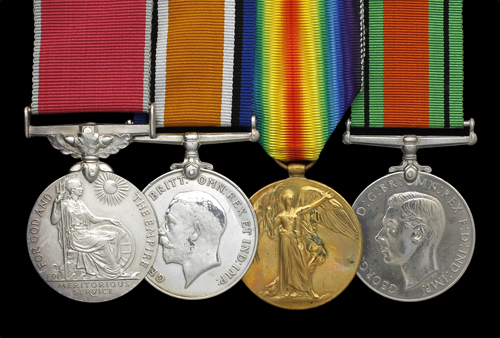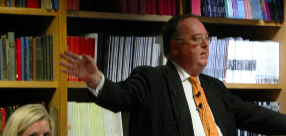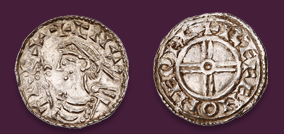
Auction: 1008 - Orders, Decorations, Campaign Medals & Militaria
Lot: 31
A Particularly Fine Second War 1944 ´Civil Division´ B.E.M. Group of Four to P.C. G.H. Shapter, Plymouth City Police, Late Royal Engineers, For the Attempted Rescue of the Crew of a Crashed Defiant Aircraft, Which in Flames, Had Come to Rest Upside Down on a Truck Containing Drums Full of Paraffin Oil a) British Empire Medal, Civil Division, G.VI.R. (George H. Shapter.) b) British War and Victory Medals (255303 Spr. G.H. Shapter. R.E.) c) Defence Medal, generally very fine (4) Estimate £ 340-380 B.E.M. London Gazette 19.12.1944 George Harold Shapter, Constable, Plymouth City Police Force ´An aircraft crashed on to a stationary goods train and came to rest upside down on a truck containing drums of paraffin oil. An explosion occurred, the aircraft caught fire immediately and the barrels of oil began to burst and ignite. Shapter ran to the scene of the crash. Without the slightest hesitation he entered the blazing aircraft and found a man trapped. The constable released the victim´s harness, dragged him from the aircraft and passed him to safety. Although the fire was burning very fiercely, he then searched inside the machine to ascertain if there was another occupant. Shapter showed courage and devotion to duty without thought for his own safety.´ Police Constable George Harold Shapter, B.E.M. (1898-1979), born Plymouth; before the war he worked for the General Post Office; served during the Great War as a Sapper, Royal Engineers, from October 1916; discharged 2.4.1919 and joined the City of Plymouth Police Force the following month; during his service with the force he was commended on four separate occasions by the Justices; he was still serving with the force at the outbreak of the Second World War and was sent as a member of the Police contingent to Exeter, 13th-18th May 1942, following a very heavy air raid on the city; Shapter was on duty at South Milton Street, 29.8.1944, when Defiant Mk III, 3434 (piloted by Flight Sergeant V.J. Fryer and crewed by Leading Aircraftman W.H. Buckland) of 691 (Anti Aircraft Co-operation) Squadron collided with the cable of a ship´s barrage balloon whilst flying at approximately 2,000 feet; Shapter had seen the aircraft having difficulties and by its´ flight path estimated that it had crashed in the vicinity of Cattedown Village, ´Police Constable Shapter was with a Police War Reserve about 500 yards away when the aircraft crashed. He instructed the War Reserve to inform the National Fire Service, call an ambulance, and inform Police Headquarters and then he ran as fast as he could to the scene of the crash. By the time he reached the aircraft the whole thing was ablaze and already some of the oil was blazing. A number of persons were standing some yards away from the blazing aircraft, but no-one was taking any action to effect a rescue from the fire. The police officer however, without the slightest hesitation, immediately entered the blazing aircraft from the windward side and there found, seated upside down in the aircraft, Leading Aircraftman Buckland.... He was able to release this man´s harness and began to drag him from the aircraft, into which he had bodily entered, when he was assisted by Yansey and, a moment later, by Weiss. Having passed over the airman to the American sailor he, still partly inside the aircraft, searched around to ascertain if there was any other person whom he could rescue, but he was unable to see the pilot and as the fire was burning very fiercely he climbed out and, with the Americans, tended the injured man.´ (Chief Constable J. Skittery´s report refers); Buckland died of his wounds the following day, Skittery continues with his report with regard to the three rescuers, ´It is my opinion that all three of these men showed a high disregard for their personal safety, but in order of priority Shapter´s courage stands out above that of the Americans. In the first place, this man of 44 had run 500 yards so as to get at the scene of the tragedy at the quickest possible moment. This in itself shows a very high sense of his duty to the public and his appreciation of what is required from a man holding the office of Constable. Before knowing that anyone else was going to help him he immediately went into the blazing aircraft. He had no reason to know that it was a target-towing machine and it might have been a fighter-bomber loaded with bombs which would explode at any moment. He took no notice of this fact, neither for that matter, did the American sailors when they came along to help.... P.C. Shapter is a man of 44 who has been, for 25 years, a patrol constable and he is very near the time when he can retire and take a pension. He is a married man and I think it is all the more praiseworthy that a man of his mature age should, without hesitation, risk his life in this most exceptionally gallant manner´ (ibid); Shapter, who had received burns and wrenched his right elbow during the rescue, retired from the force 31.12.1945, having served 26 years and 8 months. Both American sailors received King´s Commendations for their Bravery.
Sold for
£900




